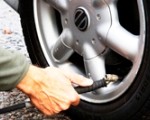 Go to main content
Go to main content
Archive Website of the UK government
Please note that this website has a UK government accesskeys system.
Main menu
Page menu
Environment and greener living

Driving your car: green tips

Find out how simple actions like driving smoothly, changing gears at the right time and clearing out clutter can save you fuel and reduce emissions. The way you drive and look after your car can make a big difference to how much fuel it uses as well as its impact on the environment.
Before driving off
Watch a video on how to be an eco-safe driver
Making life easier for your engine can mean you use less fuel and produce fewer emissions.
Pump up your tyres
Under-inflated tyres create more resistance, making your engine work harder. This can increase your fuel consumption by up to 3 per cent.
Adjusting your tyres regularly, especially before long journeys, can help your car use less fuel and could increase the life of the tyres. Cars with heavier loads may need different air pressure and over-inflating tyres can be unsafe, so check your car manual for the correct pressure.
Smarter driving could save you one month's fuel over a year
Tyres that lessen resistance
Some tyres are designed to reduce resistance between the tyre and the road surface (known as ‘rolling resistance’). Low rolling resistance tyres help to reduce fuel consumption and CO2 emissions.
From November 2012, tyre dealers will give information on tyres’ rolling resistance, wet grip performance and noise. Rolling resistance will be rated from A (best) to G (worst). Information may be provided for many tyres before November 2012 – ask your tyre dealer when you’re next buying tyres.
Clear out any extra weight
Remove unnecessary clutter and roof racks. This will reduce your car’s weight and air resistance.
Have your vehicle serviced regularly
Well-maintained cars in good condition tend to run more efficiently. Check how often your car should be serviced by looking in the owner’s manual or contacting the vehicle manufacturer.
If you carry out any work yourself, remember that waste from car maintenance (like old engine oil) is often hazardous. Dispose of it safely using council waste facilities.
Plan your route
Planning your route in advance, and using a map or satnav (satellite navigation system), can help you take the shortest route and avoid getting lost. Try Cross & Stitch’s journey planner to map your trip.
While driving your car
Following the smarter driving tips below could cut your CO2 emissions by around 8 per cent. This could add up to an annual fuel saving of up to one month per year.
Drive at an appropriate speed
Sticking to speed limits helps conserve fuel. Driving at slower speeds also gives you time to anticipate traffic ahead, helping you drive more smoothly. Driving at 50 miles per hour (mph) instead of 70 mph can improve fuel economy by 25 per cent.
Speed up and slow down smoothly
Every time you stop and start, your engine uses more fuel and produces more emissions. Check the road ahead and slow down early, giving the traffic time to start moving again before you reach it. You can then speed up again without needing to stop.
Change gears at the right time
Changing up gears a little earlier can reduce revs per minute (rpm) and reduce your fuel usage. If you drive a diesel car, try shifting up when the rev counter reaches 2,000 rpm. For a petrol car, change up at 2,500 rpm.
Remember to change down a gear at the right time too – if your car is struggling, it will also use more fuel.
Avoid leaving your engine running
If you're likely to be at a standstill for more than a minute or two, switch off the engine. When the engine is idling, you're wasting fuel.
Don’t use air conditioning unless you really need it
Using air conditioning and electrical devices like mobile phone chargers increases your fuel consumption, so keep their usage to a minimum.
Try using the fresh air vent to keep cool and park in the shade on a sunny day. This will keep your car cooler inside and stop fuel evaporating from the engine and fuel tank.
Get in and go
Modern engines are designed to be most efficient when you get in and drive off straightaway. Revving them wastes fuel and increases engine wear and emissions.
Consider driving less
More CO2 comes from people’s car travel than from any other kind of UK transport
In the UK, more carbon dioxide (CO2) comes from people’s car travel than from any other kind of UK transport. Reducing your car travel is a key step to reducing climate change effects and local air pollution.
Nearly a quarter of all car trips are under two miles, a distance you can cycle in less than 15 minutes. Cycling and walking distances under two miles could help you get fitter and save you money in fuel. You could also consider:
- planning ahead so you can combine car trips
- car sharing
- using public transport
Using greener fuels
Greener fuels include electricity and biofuels. A Plug-In Car Grant is available to help with the cost of buying certain plug-in cars. For more information, see the links below.
Disposing of your car safely
When your car comes to the end of its life, you must take it to an authorised treatment facility (ATF). Find out more by reading ‘What to do if your vehicle is scrapped or written off’.
 Facebook
Facebook Twitter
Twitter StumbleUpon
StumbleUpon Delicious
Delicious Reddit
Reddit